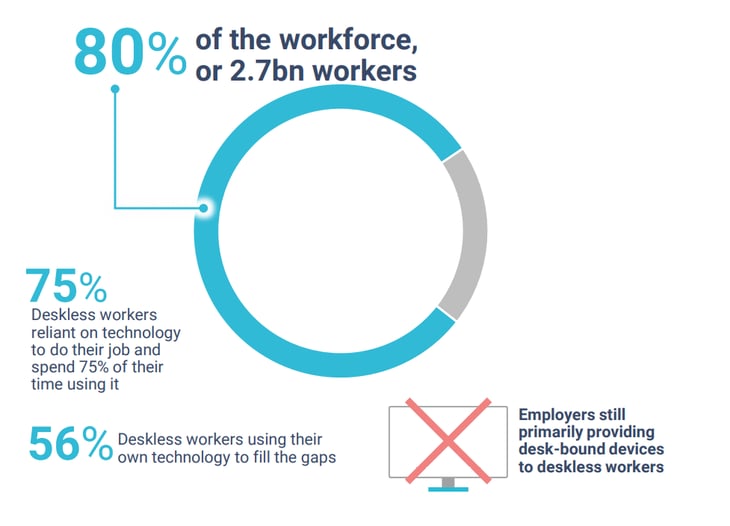Workers with no desks
According to the study “The state of technology for the deskless workforce” published by Emergence at the end of 2020, 80% of the workforce today is not operating behind a desk or from an office.
This represents an estimated total of 2.7 billion workers across the world. A large number of this deskless workforce can be found across a wide range of industries, including healthcare, agriculture, transportation, retail, or manufacturing. These frontline workers are the backbone of the global economy.
However, while the vast majority of today’s enterprise organizations invest in new and innovative technologies to maintain a competitive advantage and win in the marketplace, many remain behind when it comes to investing in the deskless workforce.

Are deskless employees the “forgotten workforce”?
When creating smart workplace solutions, such as collaborative software, videoconferencing platforms, or team communication tools, hi-tech companies don’t necessarily think about frontline workers, but rather design their products for office usage only. This means that they are simply ignoring the vast majority of the global workforce, i.e. 80%.
An explanation for this could be that tech entrepreneurs and software designers do not have any industrial professional background, and never worked in frontline workers' positions. They haven’t experienced the specific challenges the deskless workforce faces every day.
The upside of this is, that there is a huge potential for hi-tech firms to get serious about the future of deskless workers. However, they will have to work to understand how their technology can help frontline workers perform better and increase satisfaction at work.
There is a huge potential for hi-tech firms to propose technologies that can help frontline workers perform better
Deskless workers need a smart workplace too
Just like office employees, frontline workers are facing daily challenges that technology could help solve. They need a smart workplace too, which means digitalizing for instance:
- organization tools such as planners, workflow boards, scheduling platforms
- work instructions and processes
- internal documentation

According to the Emergence’s survey, 75% of deskless workers are reliant on technology to do their job and spend 75% of their time using it, but 60% of them are dissatisfied with the technology they are given: digital tools are described as too slow, non-collaborative, outdated, or difficult to understand and handle.
Since many solutions are deskbound, they are not necessarily available on smartphones or tablets, and hence not suited for workers in mobility. Therefore, 56% of deskless workers are using their own technology to fill the gap.
Efficient technologies for frontline workers
Even if the pandemic has accelerated the adoption of new technologies, still 25% of companies state that they don’t know if any technology is available for their industry and their use case.
Frontline workers need feature-rich, empowering and engaging smart workplace solutions too
In conclusion, the deskless workforce’s need for digital tools represents a great business opportunity for tech companies, with billions of potential users. Creating feature-rich, empowering, and engaging experiences should be their driving force when creating a smart workplace for frontline workers. This will lead to improved working conditions, far more productive workers, and increased overall job satisfaction.


